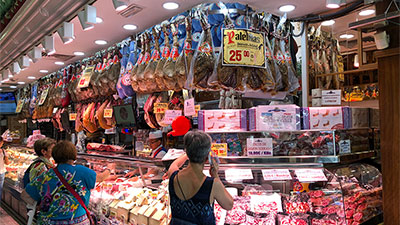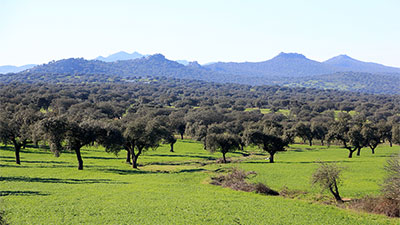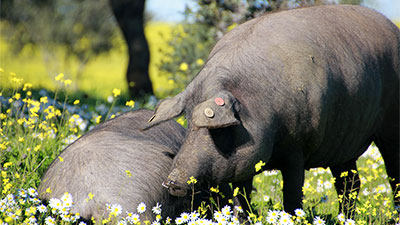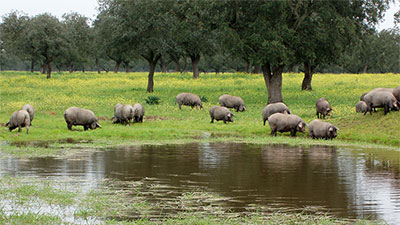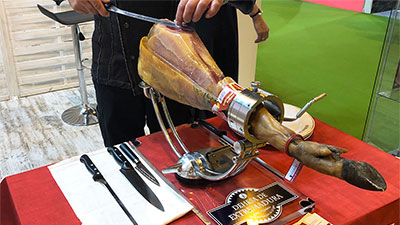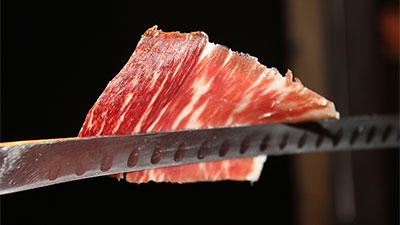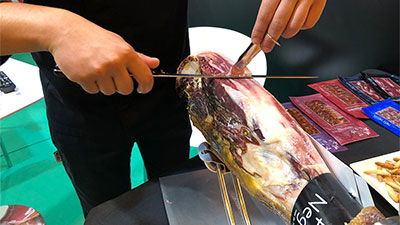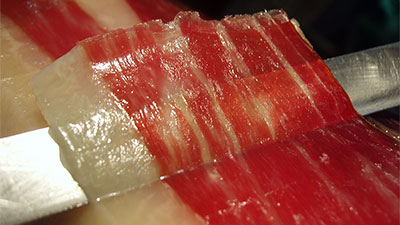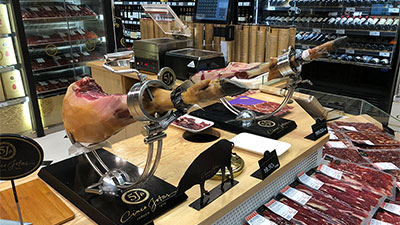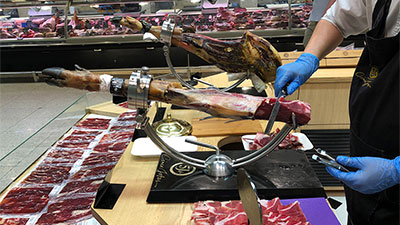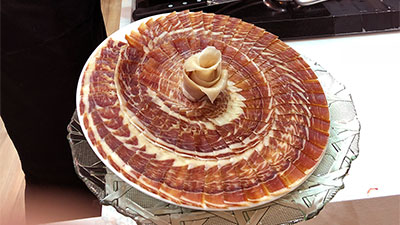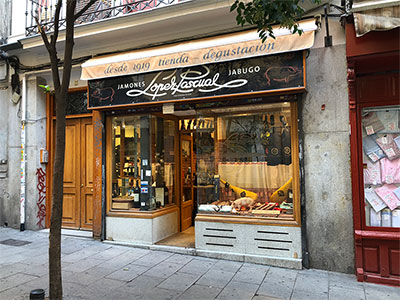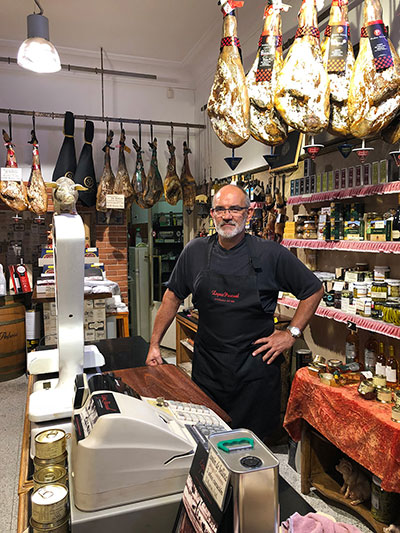Meats and Sausages
Spanish Hams
Pigs in Europe - in the winter time, usually around Christmas, a typical pig in Europe would be slaughtered, which was a kind of local celebration known as “la matanza” (the slaughter). It was a social event where families and neighbors participated together, sharing duties, tasks, and knowledge. This fiesta would go on for a few days, and a pig would be transformed into various products; the ham, a noble cut, would be salted. Iberian pigs are slaughtered later, around March, to allow them to gain more weight, but what is more important is to develop unique marbled meat from eating oak acorns.
Dry hams are big business and national pride in Spain. A deli store in Madrid.
Iberian Pig
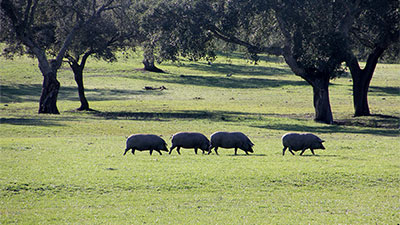 Fall - from October to February, the trees produce acorns, and attendants shake the branches with long rakes to lose them up. At that point, the diet is strictly limited to oak acorns for the best quality jamón ibérico or a mix of acorns and commercial feed for lower grades of ham. In March, the pigs are processed soon after the fattening period.
Fall - from October to February, the trees produce acorns, and attendants shake the branches with long rakes to lose them up. At that point, the diet is strictly limited to oak acorns for the best quality jamón ibérico or a mix of acorns and commercial feed for lower grades of ham. In March, the pigs are processed soon after the fattening period.
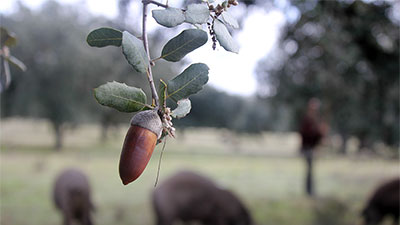 Oak acorns - (belotas)have been the perfect food for the Iberian pig. A smaller encina acorn is much sweeter than a larger alcornoque one. Oak acorns are very hard but edible and were commonly milled to an oak powder and then used as flour to bake oak bread. Or, made into a liquor called “beso de bellota” (Oak Acorn Kiss) which is still sold today.
Oak acorns - (belotas)have been the perfect food for the Iberian pig. A smaller encina acorn is much sweeter than a larger alcornoque one. Oak acorns are very hard but edible and were commonly milled to an oak powder and then used as flour to bake oak bread. Or, made into a liquor called “beso de bellota” (Oak Acorn Kiss) which is still sold today.
Jamón Ibérico
Iberico ham (Jamón Ibérico), also called “pata negra” (black foot), is a type of cured ham produced only in Spain. It is at least 75% black Iberian pig, also called the cerdo negro (black pig). According to Spain’s Denominación de Origen rules on food products, jamón ibérico may be made from cross-bred pigs as long as they are at least 75% ibérico. Pigs are slaughtered at the age of 8-9 months, having a weight of 150-170 kg (330-374 lbs). Salt is added at 4-7% in relation to the weight of a ham.
Jamonería López Pascual
Jamonería López Pascual
Calle Corredera Baja de San Pablo, 13 28004 Madrid, Spain
www.lopezpascual.com
Family-run deli since 1919 in the same location specializing in top quality ham and meat products derived from Iberian pig such as shoulders and sausages. Also, cheeses, olives, wine, and champagne.
Every year, he travels to hand pick his Jabugo Hams to Jabugo in the province of Huelva, in southwestern Spain and in the middle of Sierra de Aracena y Picos de Aroche Nature Park. Thanks to its location in Spain, there is a microclimate due to its vegetation, environments, and features, becoming a key element in producing some of the best hams all over.
Jamón Serrano
Serrano Ham (Jamón Serrano) is made from the “Landrace” breed of white pig and is not to be confused with the much more expensive and entirely different Jamón Ibérico. The manufacturing process remains similar to Iberico Ham; the main difference lies in the type of pork used.
Manufacturing process for Spanish Hams
1. Salting. Traditional production method uses only salt without adding nitrates, although purified sea salt is often mixed with common rock salt. Sea salt contains many minerals and can react differently with meat proteins and fats. The salt is added at 4 - 7% in relation to the weight of a ham. Using less salt may not prevent the growth of spoilage and pathogenic bacteria and will lower the final quality of the ham. Such an amount of salt immediately removes moisture from meat cells, lowering the meat's water activity. As a result, less moisture is available to bacteria, and the meat becomes more stable. The salting process takes place at 40° F (4° C), 85-95% humidity to create more difficult conditions for bacteria to grow. A rule of thumb calls for 2 days for each 1 kg of meat; for example, the 8 kg (17.6 lbs) ham will be salted for 16 days. After the salting stage, hams are thoroughly brushed off to remove excess salt.
2. Equalization. Equalization, sometimes called post-salting, takes place at 37- 42° F (3 - 6° C), 85-95% humidity, and continues for about 40 days. Equalization is the time after the excess cure has been removed from the product, at the end of the cure contact period until the product is placed in the drying room and the drying period begins.
3. Drying/Ripening. This is the longest stage and lasts 10-12 months.
During this stage, the ham develops its characteristic flavor and aroma due to complex reactions between enzymes, meat proteins, and fats. With time the ham loses moisture, but the salt remains inside, increasing its proportional content. As the ham becomes more stable in time, the temperatures are increased, which increases the speed of internal reactions and decreases maturation time. The ripening continues in a few cycles: the temperature starts at 53-57° F (12-14° C), 60-80% humidity, and increases up to 75-93° (24-34° C), 70-90% humidity. The ripening takes about 5 months for Serrano Ham and 10 months for Iberico Ham. The high humidity creates better conditions for mold to develop, which often happens. After ripening is completed, a thin layer of meat or fat is cut off from the surface if it has mold on it.
4. Storing. Then the hams are stored at around 53° F (12° C), 75% humidity for up to a year. The process may take up to 2 years or longer for the highest quality Iberico hams.

